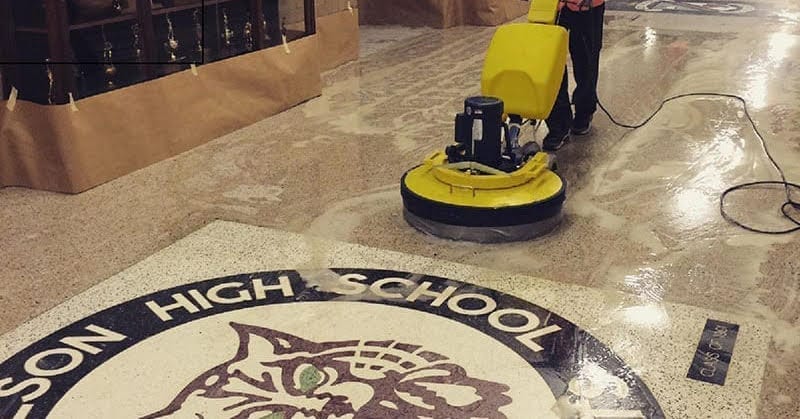Jump To:
- What is terrazzo and how is it made?
- Types of terrazzo Binders: cement vs. epoxy
- What techniques are used for Terrazzo floor restoration?
- Best practices for terrazzo floor tile care and cleaning
What is Terrazzo and How is it Made?
With such a versatile array of designs, it’s no wonder terrazzo remains a popular flooring option for hotels, airports, schools, hospitals, office buildings and more.
It graces historic landmarks from George Washington’s Mount Vernon estate to the Hollywood Walk of Fame, and archaeologists have even discovered 10,000-year-old terrazzo-like floors in modern-day Turkey.
But what is terrazzo? What is it made of and why is it such a popular choice? To put it simply – terrazzo is a composite material consisting of chips and a binder. Chips can be made from a number of materials including marble, granite, quartz, glass and shell, held together with a binder, usually either cement or epoxy.
The product may be poured into place or made from prefabricated tiles, separated by divider strips of aluminum (epoxy only), zinc, brass or plastic add the finishing touch.

Types of Terrazzo Floor Binders: Cement vs. Epoxy
Cement and epoxy are the most commonly used terrazzo binders. What is the difference between the two and how do you know which is right for your building?
Advantages of Epoxy-Based Terrazzo
Epoxy-based terrazzo began appearing in more buildings in the 1970s, and “really took off in the 90s,” according to stone floor expert and Stone Masters founder Vic LaRico, now an Account Manager with Mid America Specialty Services. The most common form of terrazzo used in commercial construction, epoxy is a thin-set terrazzo system made from a two-component resin that bonds directly to a concrete slab.
Some of the advantages of epoxy-based terrazzo include:
- Offering of a wide selection of colors and finish options,
- Lighter weight,
- Significant strength compared to other materials,
- Quick installation, and
- An impermeable finish.
However, epoxy is not suitable for exteriors and may require moisture mitigation, as the topping is not vapor-permeable. When it comes to restoration, an epoxy floor is usually just stripped and resealed. It’s more challenging to restore but less expensive to install.
Advantages of Cement-Based Terrazzo
Cementitious terrazzo usually comes in three forms:
- Monolithic uses a ½” terrazzo topping bonded directly to a concrete slab. Panels are poured directly into the metal divider strips.
- Sand cushion terrazzo begins with a bottom layer of ⅛” sand dusting, called the isolation sheet, which creates a floating floor that resists cracking. The next layer is a 2 ½”-3” wire reinforced mud bed made from a sand-and-cement mixture. Terrazzo is poured over the mud bed and metal divider strips embedded while the mud bed is still wet.
- Rustic or washed terrazzo is typically found on exterior walking surfaces and has a slip-resistant textured finish.
A cementitious terrazzo floor can be refinished just like natural stone. LaRico has restored a cementitious floor dating back to the 1880s.
Learning about the different types of terrazzo flooring and how to best install, clean, and restore them is important. Having this knowledge will help future restoration services.
Techniques for Terrazzo Floor Restoration and Maintenance
Similar to natural stone, terrazzo floors benefit from regular diamond polishing and burnishing.
To achieve natural shine and clarity, stone floor professionals from Mid America Specialty Services hone and polish the surface with a series of progressively finer diamond grits, until the desired level of gloss is achieved.
“Terrazzo can be a floor for life,” LaRico explains, “but it has to be maintained.”
- A cementitious terrazzo floor can be refinished just like natural stone. LaRico has restored a cementitious floor dating back to the 1880s.
- An epoxy floor is usually just stripped and resealed. It’s more challenging to restore but less expensive to install.
The National Terrazzo and Mosaic Association recommends a sealer be applied after final polishing to prevent spills from penetrating. LaRico emphasizes that both cementitious and epoxy terrazzo require a sealer that allows the floor to breathe.
Additionally, if the floor is improperly sealed, more cracks will appear. Some cracks may be structural issues, but others will stem from hydrostatic pressure buildup caused by a sealer not allowing the floor to breathe. A quality terrazzo floor sealer will also result in an adequate slip coefficient.
Spills should be cleaned up immediately to avoid long-term exposure to moisture and to prevent staining.
Best Practices for Terrazzo Floor Tile Care & Cleaning
With all of these recommendations and other knowledge in mind, there are a lot of best practices we can apply related to terrazzo floor maintenance and restoration. Here are some of the most important:
- Daily terrazzo floor care includes dust mopping and cleaning stubborn stains with a neutral cleaner diluted in warm water.
- Once a week, a damp mop can be used on lightly soiled floors. Heavily soiled terrazzo should be cleaned with a buffing machine.
- As needed, a stone floor expert will strip away old sealer and finish coats, and then reseal the terrazzo to restore function and appearance.
- Maintenance products developed specifically for terrazzo will have a neutral pH and be free of harsh chemicals.
Terrazzo Floor Maintenance Plans from Mid America Specialty Services
From installation, to cleaning, to maintenance, to restoration – we can help you through every stage of the process. Contact Mid America Specialty Services today to learn more about maintaining the safety and appearance of the terrazzo floors in your facility.